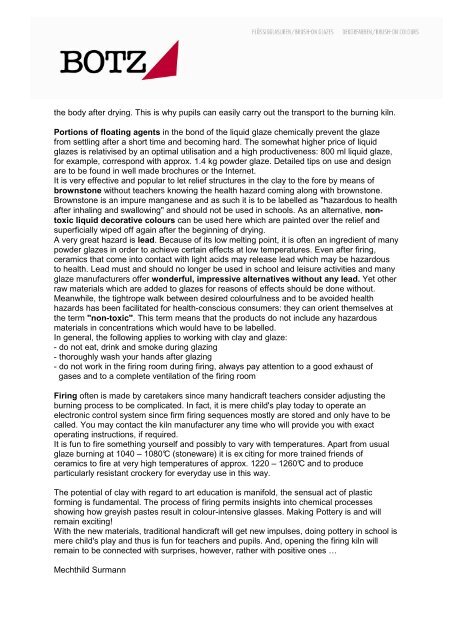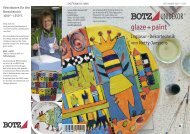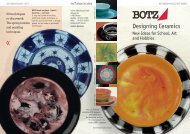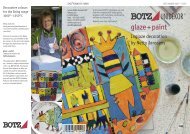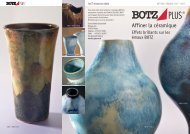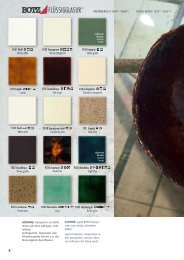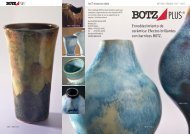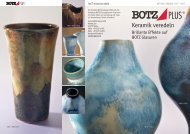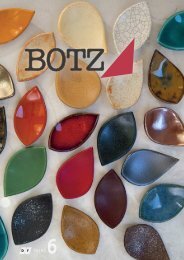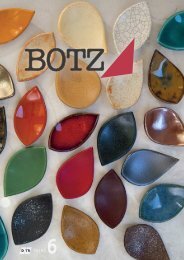Chances and risks when making pottery in school - BOTZ Glasuren
Chances and risks when making pottery in school - BOTZ Glasuren
Chances and risks when making pottery in school - BOTZ Glasuren
Create successful ePaper yourself
Turn your PDF publications into a flip-book with our unique Google optimized e-Paper software.
the body after dry<strong>in</strong>g. This is why pupils can easily carry out the transport to the burn<strong>in</strong>g kiln.<br />
Portions of float<strong>in</strong>g agents <strong>in</strong> the bond of the liquid glaze chemically prevent the glaze<br />
from settl<strong>in</strong>g after a short time <strong>and</strong> becom<strong>in</strong>g hard. The somewhat higher price of liquid<br />
glazes is relativised by an optimal utilisation <strong>and</strong> a high productiveness: 800 ml liquid glaze,<br />
for example, correspond with approx. 1.4 kg powder glaze. Detailed tips on use <strong>and</strong> design<br />
are to be found <strong>in</strong> well made brochures or the Internet.<br />
It is very effective <strong>and</strong> popular to let relief structures <strong>in</strong> the clay to the fore by means of<br />
brownstone without teachers know<strong>in</strong>g the health hazard com<strong>in</strong>g along with brownstone.<br />
Brownstone is an impure manganese <strong>and</strong> as such it is to be labelled as "hazardous to health<br />
after <strong>in</strong>hal<strong>in</strong>g <strong>and</strong> swallow<strong>in</strong>g" <strong>and</strong> should not be used <strong>in</strong> <strong>school</strong>s. As an alternative, nontoxic<br />
liquid decorative colours can be used here which are pa<strong>in</strong>ted over the relief <strong>and</strong><br />
superficially wiped off aga<strong>in</strong> after the beg<strong>in</strong>n<strong>in</strong>g of dry<strong>in</strong>g.<br />
A very great hazard is lead. Because of its low melt<strong>in</strong>g po<strong>in</strong>t, it is often an <strong>in</strong>gredient of many<br />
powder glazes <strong>in</strong> order to achieve certa<strong>in</strong> effects at low temperatures. Even after fir<strong>in</strong>g,<br />
ceramics that come <strong>in</strong>to contact with light acids may release lead which may be hazardous<br />
to health. Lead must <strong>and</strong> should no longer be used <strong>in</strong> <strong>school</strong> <strong>and</strong> leisure activities <strong>and</strong> many<br />
glaze manufacturers offer wonderful, impressive alternatives without any lead. Yet other<br />
raw materials which are added to glazes for reasons of effects should be done without.<br />
Meanwhile, the tightrope walk between desired colourfulness <strong>and</strong> to be avoided health<br />
hazards has been facilitated for health-conscious consumers: they can orient themselves at<br />
the term "non-toxic". This term means that the products do not <strong>in</strong>clude any hazardous<br />
materials <strong>in</strong> concentrations which would have to be labelled.<br />
In general, the follow<strong>in</strong>g applies to work<strong>in</strong>g with clay <strong>and</strong> glaze:<br />
- do not eat, dr<strong>in</strong>k <strong>and</strong> smoke dur<strong>in</strong>g glaz<strong>in</strong>g<br />
- thoroughly wash your h<strong>and</strong>s after glaz<strong>in</strong>g<br />
- do not work <strong>in</strong> the fir<strong>in</strong>g room dur<strong>in</strong>g fir<strong>in</strong>g, always pay attention to a good exhaust of<br />
gases <strong>and</strong> to a complete ventilation of the fir<strong>in</strong>g room<br />
Fir<strong>in</strong>g often is made by caretakers s<strong>in</strong>ce many h<strong>and</strong>icraft teachers consider adjust<strong>in</strong>g the<br />
burn<strong>in</strong>g process to be complicated. In fact, it is mere child's play today to operate an<br />
electronic control system s<strong>in</strong>ce firm fir<strong>in</strong>g sequences mostly are stored <strong>and</strong> only have to be<br />
called. You may contact the kiln manufacturer any time who will provide you with exact<br />
operat<strong>in</strong>g <strong>in</strong>structions, if required.<br />
It is fun to fire someth<strong>in</strong>g yourself <strong>and</strong> possibly to vary with temperatures. Apart from usual<br />
glaze burn<strong>in</strong>g at 1040 – 1080°C (stoneware) it is ex cit<strong>in</strong>g for more tra<strong>in</strong>ed friends of<br />
ceramics to fire at very high temperatures of approx. 1220 – 1260°C <strong>and</strong> to produce<br />
particularly resistant crockery for everyday use <strong>in</strong> this way.<br />
The potential of clay with regard to art education is manifold, the sensual act of plastic<br />
form<strong>in</strong>g is fundamental. The process of fir<strong>in</strong>g permits <strong>in</strong>sights <strong>in</strong>to chemical processes<br />
show<strong>in</strong>g how greyish pastes result <strong>in</strong> colour-<strong>in</strong>tensive glasses. Mak<strong>in</strong>g Pottery is <strong>and</strong> will<br />
rema<strong>in</strong> excit<strong>in</strong>g!<br />
With the new materials, traditional h<strong>and</strong>icraft will get new impulses, do<strong>in</strong>g <strong>pottery</strong> <strong>in</strong> <strong>school</strong> is<br />
mere child's play <strong>and</strong> thus is fun for teachers <strong>and</strong> pupils. And, open<strong>in</strong>g the fir<strong>in</strong>g kiln will<br />
rema<strong>in</strong> to be connected with surprises, however, rather with positive ones …<br />
Mechthild Surmann


